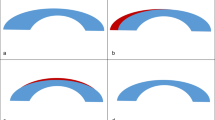Abstract
Purpose
To evaluate the safety and refractive stability following LASIK retreatment over a four-year follow-up period.
Methods
In this retrospective study, 60 eyes of 52 patients underwent LASIK retreatment for residual refractive errors after LASIK. Retreatment was performed by lifting the original flap followed by laser ablation of the stromal bed. The main outcome measures at the latest follow-up visit were efficacy, predictability, safety and stability. The mean follow-up time after retreatment was 22.3 ± 10.5 (range 12–48 months).
Results
The baseline mean spherical equivalent (SE) was −4.85 ± 2.57 dioptres (D) (range +2.25 to −11.75 D). At the latest follow-up visit, the uncorrected visual acuity (UCVA) was 6/9 or better in 88% of the eyes, the mean SE was −0.33 ± 0.8 D (−2.50 to +2.25 D), and 77% of the eyes were within ±0.50 D of target refraction. None of the patients lost lines of best corrected visual acuity (BCVA) and 25 eyes (41%) gained one or more lines. Three eyes (5%) developed peripheral epithelial in-growth and none of the patients had corneal ectasias or retinal complications.
Conclusion
LASIK retreatment is a safe and effective procedure for correcting residual refractive errors after LASIK. After retreatment, the visual and refractive outcome remained stable during the four-year follow-up period of the study.




Similar content being viewed by others
Abbreviations
- BCVA:
-
Best corrected visual acuity
- D:
-
Dioptres
- FV:
-
Final visit
- LASEK:
-
Laser subepithelial keratomileusis
- LASIK:
-
Laser in situ keratomileusis
- IOP:
-
Intraocular pressure
- Mos:
-
Months
- Preop:
-
Before initial LASIK
- PRK:
-
Photorefractive keratectomy
- RE:
-
At retreatment time
- SE:
-
Spherical equivalent
- UCVA:
-
Uncorrected visual acuity
- Yrs:
-
Years
- 1 wk:
-
One week after initial LASIK
- 3 mo:
-
Three months after initial LASIK
- 1 wk-r:
-
One week after retreatment
References
Tahzib N, Bootsma S, Eggink F et al (2005) Functional outcomes and patient satisfaction after laser in situ keratomileusis for correction for myopia. J Cataract Refract Surg 31:1943–1951
Garamendi E, Pesudovs K, Elliot D (2005) Changes in quality of life after laser in situ keratomileusis for myopia. J Cataract Refract Surg 31:1537–1543
Jabbur N, Sakatani K, O’Brien T (2004) Survey of complications and recommendations for management in dissatisfied patients seeking a consultation after refractive surgery. J Cataract Refract Surg 30:1867–1874
Carones F, Vigo L, Carones AV, Brancato R (2001) Evaluation of photorefractive keratectomy retreatments after regressed myopic laser in situ keratomileusis. Ophthalmology 108:1732–1737
Li Y, Li JH, Zhou F (2005) LASEK for the correction of residual myopia and astigmatism after LASIK. Zhonghua Yan Ke Za Zhi. 41:981–985
Brahma A, McGhee C, Craig J et al (2001) Safety and predictability of laser in situ keratomileusis enhancement by flap reelevation in high myopia. J Cataract Refract Surg 27:593–603
Febbraro J, Buzard K, Friedlander M (2000) Reoperations after myopic laser in situ keratomileusis. J Cataract Refract Surg 26:41–48
Lyle AW, Jin G (2000) Retreatments after initial laser in situ keratomileusis. J Cataract Refract Surg 26:650–659
Patel N, Clinch T, Weis J (2000) Comparison of visual results in initial and retreatment laser in situ keratomileusis procedures for myopia and astigmatism. Am J Ophthalmol 130:1–11
Prez-Santonja J, Ayala M, Sakla H et al (1999) Retreatments after laser in situ keratomileusis. Ophthalmology 106:21–28
Netto MW, Wilson SE (2004) Flap lift for LASIK retreatment in eyes with myopia. Ophthalmology 111:1362–1367
Littell RC, Milliken GA, Stroup WW, Wolfinger RD (1996) SAS® systems for mixed models. SAS institute Inc., Cary, NC, USA
Hersh P, Fry K, Bishop D (2003) Incidence and associations of retreatment after LASIK. Ophthalmology 110:748–754
O’Doherty M, O’Doherty J, O’Keefe M (2006) Outcome in LASIK for myopia in women on hormone replacement therapy. J Refract Surg 22:350–353
Albeitz JM, Lenton LM, McLennan SG (2004) Chronic dry eye and regression after laser assisted keratomileusis for myopia. J Cataract Refract surg 30:675–684
Fan-Paul NI, Li J, Miller JS, Florakis GJ (2002) Night vision disturbances after corneal refractive surgery. Surv Ophthalmolo 47:533–546
Schallhorn SC, Kaupp SE, Tanzer DJ et al (2003) Pupil size and quality of vision after LASIK. Ophthalmology 110:1606–1614
Bailey MD, Mitchell GL, Dhaliwal DK et al (2003) Patient satisfaction and visual symptoms after laser in situ keratomileusis. Ophthalmology 110:1371–1378
Brunette I, Gresset J, Boivin J-F et al (2000) Functional outcome and satisfaction after photorefractive keratectomy. Part 2: survey of 690 patients; the Canadian refractive surgery research group. Ophthalmology 107:1790–1796
Pop M, Payette Y (2004) Risk factors for night vision complaints after LASIK for Myopia. Ophthalmology 111:3–10
Davis EA, Hardten DR, Lindstrom M et al (2002) LASIK enhancements: a comparison of lifting to recutting the flap. Ophthalmology 109:2308–2314
Rubenfeld RS, Hardten DR, Donnenfeld ED et al (2003) To lift or recut: changing trends in LASIK enhancements. J Cataract Refract Surg 29:2306–2317
Jin G, Merkley K (2006) Conventional and wavefront-guided myopic LASIK retreatment. Am J Ophthalmol 141:660–668
Alió JL, Montés-Mico R (2006) Wavefront-guided versus standard LASIK enhancement for residual refractive errors. Ophthalmology 113:191–197
Author information
Authors and Affiliations
Corresponding author
Rights and permissions
About this article
Cite this article
Saeed, A., O’Doherty, M., O’Doherty, J. et al. Analysis of the visual and refractive outcome following laser in situ keratomileusis (LASIK) retreatment over a four-year follow-up period. Int Ophthalmol 27, 23–29 (2007). https://doi.org/10.1007/s10792-007-9054-9
Received:
Accepted:
Published:
Issue Date:
DOI: https://doi.org/10.1007/s10792-007-9054-9




